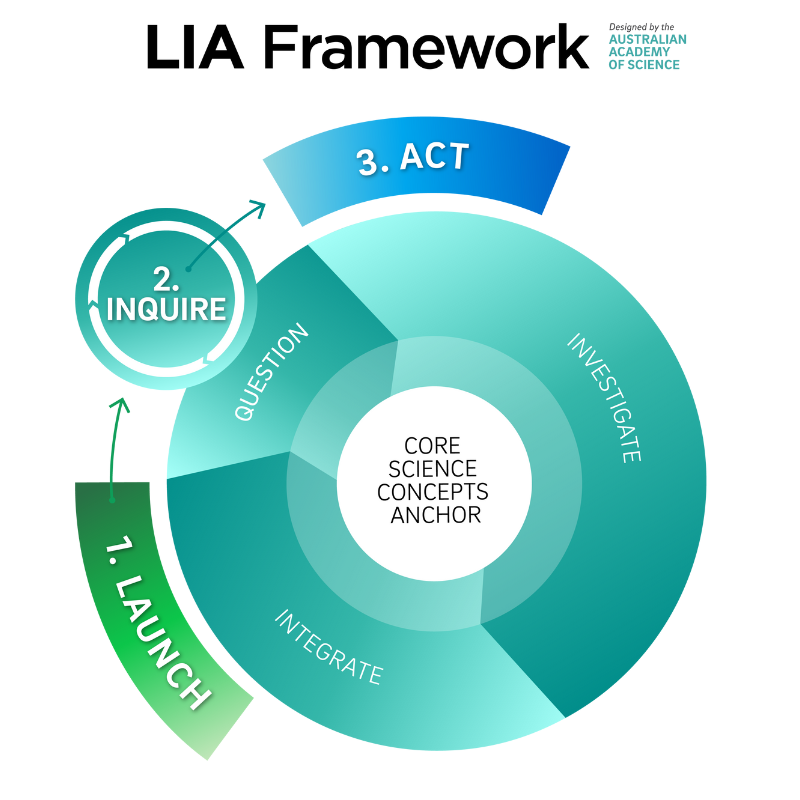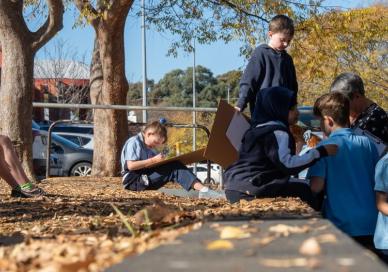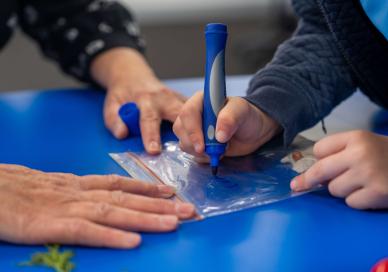Australian Academy of Science Education has developed digital teaching resources that align with Australian Curriculum V9 and which include embedded just-in-time professional learning to support the teaching and learning of mathematics and science in Australian schools, Foundation to Year 10. Teachers have the opportunity to link the guided teaching sequences to contemporary education research that is part of the ‘Teaching with Intent’ education approach developed by the Australian Academy of Science.
While the focus remains on scientific literacy, it also supports teachers to increase the science capital (science-related knowledge, attitudes, experiences and resources) in their classrooms and the associated science identity of students.
Godec, King and Archer (2017)1 describe the benefits of increasing the science capital for students.
Improves students’ understanding and recall of science content.
Helps students find science more personally relevant.
Deepens students’ appreciation of science.
Widens and increases students’ engagement with science in lessons.
Improves students’ behaviour during science lessons.
Increases the proportion of students seeing themselves as ‘sciencey’.
The PISA 2024 Strategic Vision and Direction for Science (2020)2 describes the importance of a student’s scientific identity to inclusion and the equity of science cultures and practices:
If we fail to pay attention to a young person’s scientific identity outcomes then we undermine the achievement and potential of scientific learning and the extent to which young people will be able to critically use and act with these competencies in life (p.12).
The implementation of the Australian Curriculum Version 9 has provided an opportunity for the Australian Academy of Science Education to reimagine science education. The result is a new framework that is designed to connect contemporary research on science education, science identity and science capital. Applicable in both the primary and secondary sectors, the framework aims to equip students with a consistent approach that builds student’s knowledge, skills, and identity that will prepare them for the scientific challenges beyond the classroom.
Evolution of the 5E model
Underpinned by research and trialled extensively in classrooms, the 5E model of inquiry has been the foundation of Primary Connections’ resources since the program’s inception in 2003. The LIA Framework (Silvester & Lawrence, 2025)3 builds upon this strong foundation and draws from the latest research to increase the emphasis on the local and global contexts, while integrating the three Science Strands of the Australian Curriculum V9 (Science Understanding, Science as a Human Endeavour and Science Inquiry). The Launch phase promotes the importance of science in the students’ lives now. The cyclic nature of the Inquire phase allows ongoing questioning and investigation to systematically clarify and refine student representations of the Core concepts, while the Act phase empowers students to use the skills and knowledge of science.
This framework is designed so that teachers can use the information and professional learning to easily modify their approach to suit the context of their students and classroom. The Australian Academy of Science aims to build the capacity of teachers to develop innovative educative teaching resources that are grounded in contemporary education research.
Table 1: Correlation between AAS Science Framework and other pedagogies
AASE Science LIA Framework | 5Es4 | International Baccalaureate5 | OpenSciEd6 | STEM (Stanford)7 | Science of Learning8 |
|---|---|---|---|---|---|
Launch Phase - Experience/ Empathise - Anchor - Elicit - Connect | Engage Explore | Tuning in | Anchoring Phenomenon | Empathise | *First impressions colour future judgement *Background stories increase engagement |
Inquire Phase - Question - Investigate - Integrate | Explore Explain Elaborate
| Finding out Sorting out Going further Making conclusions | Navigation Problematising Investigation Putting the pieces together | Define Ideate
| *Pre-activation questions guides learning *Spacing out practice enhances memory *Visible learning *Formative feedback |
Act Phase - Anchor - Connect - Design - Communicate | Elaborate Evaluate | Taking action | Prototype Test | *Embrace error to improve learning *Active recall trumps passive review |
LIA Framework
Watch this short video that introduces the LIA Framework.

Launch phase
The Launch phase is designed to increase the science capital in a classroom by asking questions that elicit and explore students’ experiences. It uses local and global contexts and real-world phenomena that encourages students to ask questions, explore concepts, and engage with the Core Concepts that anchor each unit.
Each Launch phase consists of a series of teaching and learning routines that provide opportunities for students to:
- Experience science in a real-world context and Empathise with the people who experience the problems science seeks to solve,
- Anchor the experience to the Core concepts that students will explore,
- Elicit students’ prior experiences, existing science capital and potential alternative conceptions related to the Core concepts,
- Connect the students’ lives, language, and interests to the anchored Core concepts.
These routines will provide opportunities for diagnostic assessment and support for students to develop the necessary representational capabilities.
The related professional learning will guide and encourage teachers to use local contexts to establish a learning community that links to the key ideas of science.
Inquire phase
The Inquire phase allows students to cycle progressively and with increasing complexity through the key science ideas related to the core concepts. Each inquire cycle is divided into three teaching and learning routines that allow students to systematically build their knowledge and skills in science and incorporate them into their current understanding of the world.
- Questions are identified and encouraged during the Launch phase of the LIA Framework. Identifying and constructing questions is the creative driver of the inquiry process. Reviewing past activities and using effective questioning techniques can influence students’ view and interpretation of upcoming content.
- Investigate: This provides students with an opportunity to explore the key ideas of science, to plan and conduct an investigation, to gather and record data. The investigations are designed to systematically develop content knowledge and skills through increasingly complex processes of structured inquiry, guided inquiry and open inquiry approaches. The data is processed to identify trends and patterns that relate to the real-world context experienced in the Launch phase.
- Integrate: Following an investigation, data is evaluated, representations consolidated and refined, and anchored to the Core concepts and key ideas of science. This makes student thinking visible and formative feedback opportunities. It may lead to further questions being asked, allowing the Inquire phase to start again.
Repeated inquiry cycles support students to deepen their understanding of the Core concepts and key ideas, improve their application of science practices, ultimately empowering them to act.
Act phase
The Act phase empowers students to use the Core concepts and key ideas of science they have learned during the Inquire phase. It provides students with opportunities to
- Anchor their understanding of the Core concepts, and
- Connect these to real-world examples experienced in the Launch phase, so that students develop the agency to,
- Design solutions to problems or ways to use their science knowledge, increase their science capital and,
- Communicate their ideas effectively to others, advancing science and influencing the community in general.
Throughout these Teaching and Learning Routines, a teacher provides formative feedback on the representations presented by students. The final product also provides opportunities for summative assessment.
By anchoring phenomena in real-world contexts, supporting students to develop their understanding of that phenomena, and applying this knowledge and understanding in new and genuine contexts, students can appreciate the relevance of their learning, and its potential impact on future decisions. In short, it moves beyond scientific literacy and increases the science capital in the classroom and science identity of the students.
References
1Godec, S., King, H., & Archer, L. (2017). The Science Capital Teaching Approach: engaging students with science, promoting social justice. University College London.
2PISA 2024 Strategic Vision and Direction for Science. (2020). https://www.oecd.org/pisa/publications/PISA-2024-Science-Strategic-Vision-Proposal.pdf pg 12
3Silvester, H., & Lawrence, J. (2025). Launch, Inquire, Act - A framework for teaching and learning science. Teaching Science Journal, 71(1), 10-21. https://issuu.com/teachingscience/docs/teaching_science_70.4_final?fr=xKAE9_zU1NQ
4Joswick, C., & Hulings, M. (2023). A Systematic Review of BSCS 5E Instructional Model Evidence. International Journal of Science and Mathematics Education. https://doi.org/10.1007/s10763-023-10357-y
5Bores-García, D., González-Calvo, G., Barba-Martín, R. A., García-Monge, A., & Hortigüela-Alcalá, D. (2023). International Baccalaureate Primary Years Programme: a systematic review. Journal of Research in International Education, 22(2), 149-163. https://doi.org/10.1177/14752409231188215
6What Research Articles have been published about OpenSciEd? (n.d.). OpenSciEd. Retrieved June 17, 2024, from https://www.openscied.org/knowledge/what-research-articles-have-been-published-about-openscied/
7Auernhammer, J., & Roth, B. (2021). The origin and evolution of Stanford University’s design thinking: From product design to design thinking in innovation management. Journal of Product Innovation Management, 38(6), 623-644.


